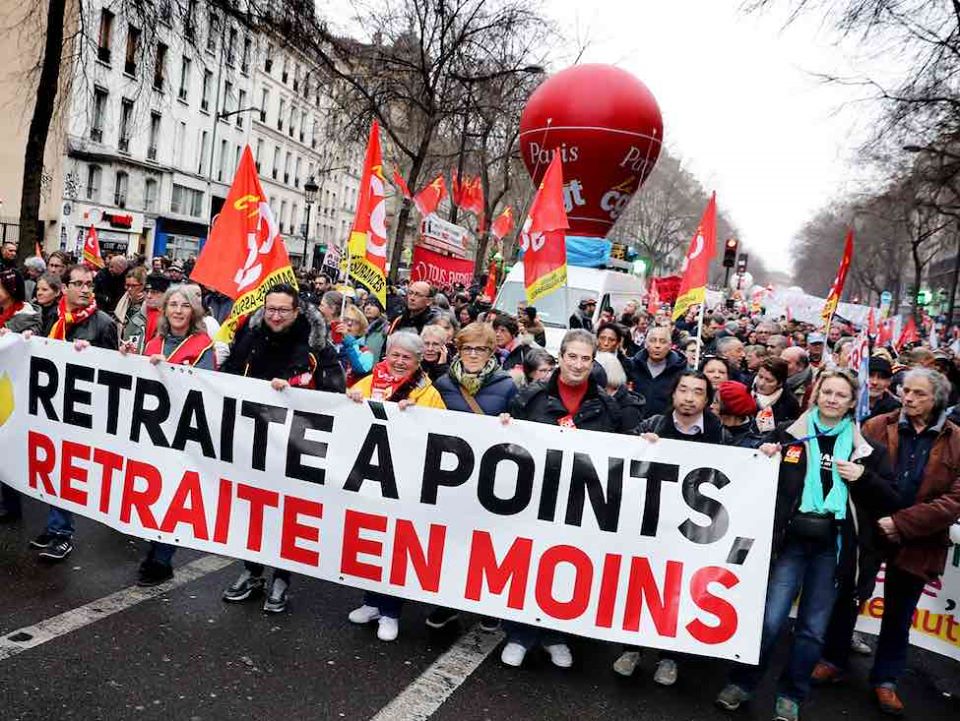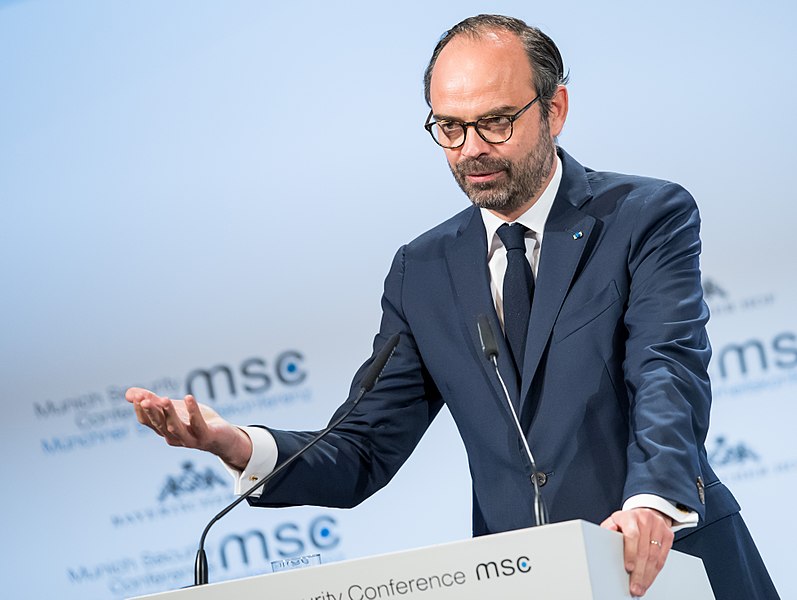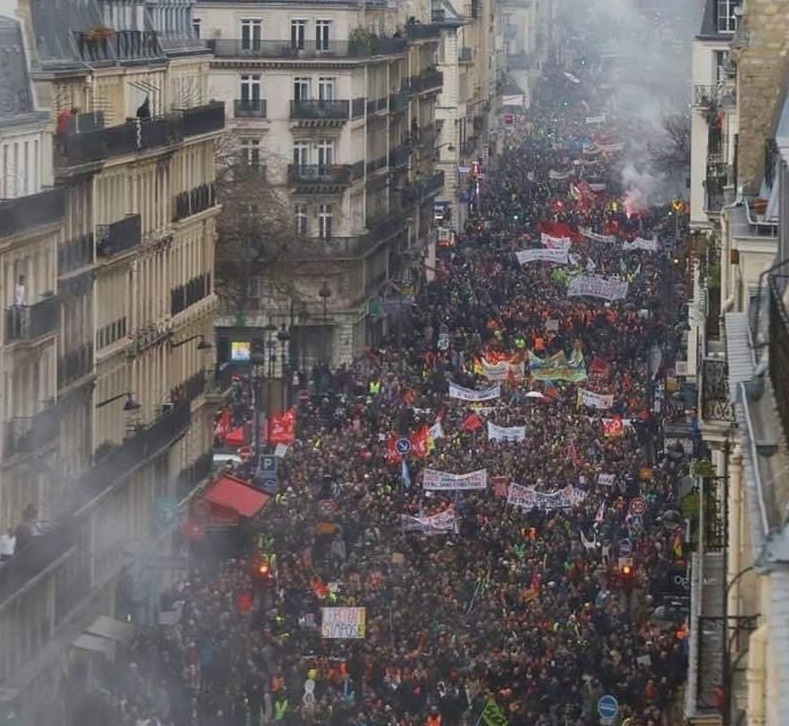The battle in France over Macron’s reactionary pension reform passed its 40th day on 13 January. A fourth interprofessional strike last Thursday and follow-up protests on the weekend brought hundreds of thousands onto the streets yet again, and further days of action have been declared up until 16 January.
In an attempt to break the united front of trade unions, the government has offered to temporarily suspend the proposed raise in the state retirement age from 62 to 64 (the so-called pivot age). This false concession is a trap that the CGT has rightly rejected, demanding the total revocation of the pension reform. But even this demand falls short. Macron has staked his political life on passing the pension reform and it will take a far greater mobilisation to beat him back. The only realistic strategy is to build for an all-out, continuous general strike involving the widest possible layers of the French working class and youth, setting the stage for a revolutionary struggle to bring down Macron’s rotten administration.
“We will continue!”
The mobilisation on 9 January was massive, with the CGT reporting 1.7m people on the streets – 370,000 in Paris alone. The turnout was smaller on the Saturday, with unions claiming 500,000 demonstrators across France and 150,000 in the capital. These numbers are perhaps exaggerated, but the ludicrous official figure (450,000 nationally on the 9th and 150,000 on the 11th) is nothing but wishful thinking on the part of the state. As attested by social media, there were hundreds of protests across the country, with big marches in Marseille, Toulouse, Nantes, Bordeaux, Lyon, Nantes, Clermont-Ferrand and elsewhere.
The mood on the Thursday demonstration was very radical, with a greater variety of workers on the streets, including rail workers with SNCF and the RATP, refinery workers, teachers, public sector employees, RTE energy workers, construction workers, librarians, lawyers – and more. Although there is some evidence of tiredness setting in, many people feel they have gone too far now to back down. This was clear from one of the central slogans on the marches: “on ira jusqu'au retrait!” (we will continue until it is withdrawn!)
Le boulevard de Magenta est noir de monde alors que le cortège n à pas encore démarré #greve9janvier #GiletsJaunes pic.twitter.com/mBPxLlDk1b
— A.D (@AD12369002) January 9, 2020
Transport workers remain the vanguard of the movement. All but two Paris Métro lines (both of which are automated) were closed on the 9th, and there was a severely diminished service on other lines, in addition to buses, trams and RER trains. TER train services were reduced by 40 percent, and there were bus replacement services on many lines. The national rail service, SNCF, was also hit with cancellations and reduced services, as was the Eurostar.
Fatigue and loss of pay has understandably taken its toll on the transport workers, resulting in them gradually returning to work in dribs and drabs. However, they rallied for the 9th, when (according to the SNCF) five times as many train drivers were on strike as the day before, with a higher observation than the last interprofessional strike on 17 December (34 percent versus 33 percent). It is truly impressive that, 40 days into an all-out strike, the workers are able to draw on deeper reserves for an even-harder push.
Spine Tingling!
— Ian56 (@Ian56789) January 9, 2020
Thousands of people sing as they march to protest in #Paris.#greve9janvier#ViolencesPolicières#GiletsJaunes pic.twitter.com/e49jweoW45
White-collar workers are still in the fray. Around half the education workforce went on strike on the 9th, with 60 percent participation in the capital. Teachers’ action could be far stronger, but the main education union (FSU) is reluctant to call a continuous strike. Additionally, a lot of hospital workers (particularly nurses and nursing assistants) were visible on the marches. Furthermore, on 10 January, following the decision of a general assembly, medical interns went on strike across France, with 60 percent of the workforce picketing. The Paris Opera remains on strike, cancelling the inaugural performance of its new season, The Barber of Seville. The company reports it has lost €12.3 million to the strike so far. In one of the most dramatic images of the day, dozens of lawyers (whose special pension regimes are under threat from Macron’s reform) cast off their robes and threw them at the feet at the Minister of Justice during a press conference on the 9th.
Private sector workers remain a minority on the demonstrations. The notable exception is workers at France’s main refineries (which are owned by private companies like Total), who are participating actively in this struggle. General assemblies of refinery workers voted to harden their action, extending a planned 72-hour stoppage to 96 hours, although it is difficult to gauge the extent to which this was observed. Given the blackmail and threatened sanctions these workers face from the bosses, their courage is exemplary. Local CGT chapters have been taking steps to protect their members at the refineries from workplace sanctions, which has helped in giving them the political and moral strength to keep up the fight.
Again, the problem of leadership
 The CGT have rightly rejected Macron's manoeuvre, but their leadership's strategy doesn't go far enough to win this fight / Image: fair use
The CGT have rightly rejected Macron's manoeuvre, but their leadership's strategy doesn't go far enough to win this fight / Image: fair use
By contrast, the national strategy of the CGT towards winning over private sector workers remains extremely limited. Part of the reason they called a follow-up demonstration on Saturday was so that private sector workers could take part without having to lose pay or face reprisals from their bosses. But this kind of action is toothless, and no substitute to building the strike in private sector workplaces by politically explaining the need to get out as many workers as possible to combat Macron’s rotten policy. Moreover, it artificially inflates the level of private sector participation. While plenty of private sector workers are sympathetic with the strike, they aren’t going to risk sanctions and loss of pay unless they’re confident of victory – a confidence the CGT leadership is failing to instil.
However, activists on the ground have been overcoming the limitations of their leadership to involve broader layers of private sector workers, to a certain extent. Notably, the main column in Paris on Thursday was led by a self-organised bloc of RATP and SNCF workers, both unionised and un-unionised. Transport workers have also apparently been reaching out to employees of the PSA Poissy Plant (which produces cars), some of whom were visible on the demonstrations. These are small steps, but they give a sense of what could be achieved if the CGT adopted a more courageous and determined national strategy.
The masses have also been driven forward by the whip of state repression. The police have become increasingly violent towards demonstrators. French prosecutors have launched an investigation into police violence after a video emerged on social media showing an officer firing an LBD riot control gun at a marcher on the 9th at point blank range, while other officers beat the rest of the crowd with batons. LBDs fire 40-millimeter rubber balls that can cause serious injury and even death if used at close quarters, and cost several gilets jaunes an eye in 2018. The police have dismissed the legal complaint, releasing a statement claiming its officers were confronted by “hostile and threatening groups", and therefore used proportionate force.
?? [FLASH] - Une vidéo filmée à #Paris, aujourd'hui, montre qu'un policier a tiré à bout portant sur un manifestant contre la réforme des #retraites (à 12s).
— La Plume Libre (@LPLdirect) January 9, 2020
Une nouvelle violence policière. #greve9janvier #manifestation#GiletsJaunes#GreveGenerale
? (@laurentbigotfr) pic.twitter.com/0KEFYWvLui
The state forces are playing with fire: it was the heavy-handed approach of the police that helped turn the gilets jaunes into an insurrectionary movement. The unions could certainly tap into the mood of anger and intensifying hatred towards the establishment, and build for a major confrontation between the workers and the government. But for now, they are keeping the struggle within safe channels.
False concessions
It was no accident that Prime Minister Édouard Philippe announced the removal of the “pivot age” (where workers must work an additional two years from 62 to 64 to claim their full pension) on Saturday. President Macron’s self-described "constructive compromise" was an attempt to cut across the demonstration. However, in this regard, he failed. After the statement was released, the demonstrators immediately renewed their chant to fight on until the pension reform is withdrawn. The workers have seen these tricks before, in the various phony “concessions” Macron promised to defuse the gilets jaunes movement. The special pension regimes are still on the chopping block, and Macron still intends to raise the official retirement age eventually. This is purely a manoeuvre, and the workers know it.
 Prime Minister Édouard Philippe's announced removal of the “pivot age” is intended to get the softer unions to withdraw / Image: Mueller
Prime Minister Édouard Philippe's announced removal of the “pivot age” is intended to get the softer unions to withdraw / Image: Mueller
But Macron doesn’t really intend to win over the workers in struggle, he is trying to get the softer union leaderships (CFTD and UNSA) to withdraw their forces. They had previously signalled that cancellation of the pivot age, which only affects older workers, would be sufficient for them to pull back. Indeed, Laurent Berger, secretary general of the CFDT, hailed the government's concession as "a victory" and celebrated Macron’s “willingness to compromise.” UNSA also welcomed the announcement.
However, the increasing class consciousness of their rank-and-file is clearly having an effect on these more-conservative unions. The fact that CFDT and UNSA are still on strike reflects pressure from below. UNSA even released a somewhat critical statement that, while it would return to the negotiating table, Macron’s announcements “do not meet the expectations of either RATP employees or UNSA-RATP”.
Macron’s other objective is to weaken public sympathy for the strike, by signalling his willingness to compromise, while making the workers look like intractable hardliners. By emphasising the special pension regimes, he is trying to convince the masses that this fight is led by “privileged” layers of the workforce, a message trumpeted by the establishment media.
Despite these efforts, support for the strike is holding at around 60 percent. Furthermore, millions of Euros have been donated to the national CGT fighting fund, while local “kitties” organised by workers have also seen generous donations from members of the public. Fabrice Archet, a 46-year-old train driver from the RER B line, which connects Paris with France’s international airports, said:
“It’s not necessarily the wealthy who give to our kitty – it’s often students and people who are struggling themselves. We need to show the government that we won’t give up, that we’re here in the street and that he [Macron] needs to listen to us.”
In contrast to the attitude of the union tops, who emphasise the pension reform in isolation, the workers’ determination, and these displays of sacrifice and solidarity from the public, show an appetite for a broader battle against Macron’s entire reactionary government of the rich. People understand that the pension reform is merely part of a wider series of attacks on working people. As Marie Sabrina, a 34-year-old teacher from Seine Saint-Denis, said: “It’s been a month since we’ve been protesting, and [Macron’s] not listening to us. He needs to listen to the street… He’s a banker. He just cares about finance and money – that he gives to his rich friends.”
These comments were echoed by André Villanueva, an Air France ground worker at Charles de Gaulle airport and CGT member, who said: “This is about people’s futures. If you’ve got a lot of money you’ll always be able to get health treatment, go on holiday and retire comfortably. This is about protecting the majority of people who haven’t and who work hard for a basic retirement.” Chantal Sevens, 67, a retired administrator from a private health company, added: “People are worried that this reform will in fact simply benefit the big groups running private pension funds. It’s about capitalism. It feels like the very principle of our social security system is under threat.”
Extend the strike, fight to the finish
The CGT rightly rejected Macron’s phony compromise as a “smokescreen”, as did the inter-union federation stationed at the union headquarters of FO, insisting in a statement that they would not stop until the pension reform was scrapped in full. However, the union leaderships’ strategy going forward leaves a lot to be desired.
They announced three days of “strikes and interprofessional convergence” from 14-16 January, culminating in a “massive inter-professional mobilisation of strikes and demonstrations” on the 16th. However, they were extremely vague about the nature of these days of action, stating the details of the interprofessional strike on the 16th would be decided at an inter-union meeting on the 15th and announced afterwards, giving the workers no time to rally their forces or prepare.
This is a continuation of the union tops’ approach of keeping workers in the dark, and treating their struggle like a tap that can be turned off and on to put pressure on Macron. In the meantime, CGT general secretary Philippe Martinez will be attending a “financing conference” to negotiate with representatives from the government. Evidently, nothing has changed in the thinking of the bureaucrats. They have no faith in the workers, their attitude is still that the masses exist only to provide leverage for closed-door negotiations with the state.
1 year + 9 weeks of massive protests in France.
— Oh boy what a shot (@ohboywhatashot) January 13, 2020
?️ || 'Lawyers in #Lyon protest against Macron government' (#Greve13Janvier)
Mainstream media will never show you this video.
We are the media now.pic.twitter.com/MxocuoHwZw
This is a losing strategy. The impact of passively calling for days of action will reap diminishing returns. None of the mobilisations thus far have been strong enough to seriously threaten the government. Macron can ride them out. It should be noted that the size of the demonstrations do not necessarily reflect the scale of the strike. In truth, the energy of the cheminots, who have now lost a month-and-a-half of pay, is not unlimited. The cracks are beginning to show. Even on the 9th, four out of five of TGV high speed services and 70 percent of Ouigo services were running as usual. Moreover, two-thirds of Transilien trains in the greater Paris region and one third of Intercité routes were running. This is a far-cry from the near-total shutdown of public transport at the beginning of December.
Despite the slogan “we will continue until it is withdrawn”, it is not so much the length of the strike that will prove decisive but its breadth. The majority of workers in France are in the private sector. These layers will not risk lost pay and sanctions unless they see a plan for victory. Even in the public sector, only a minority is on strike. If the cheminots are isolated, they will be defeated, in spite of their courage and sacrifice. It is the duty of the union federations to properly build for a national, continuous strike with the aim of bringing French society to a standstill. This, and only this, can ensure victory.

